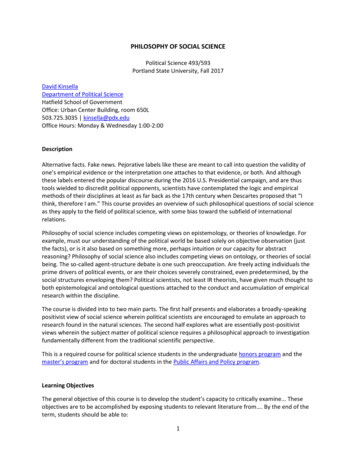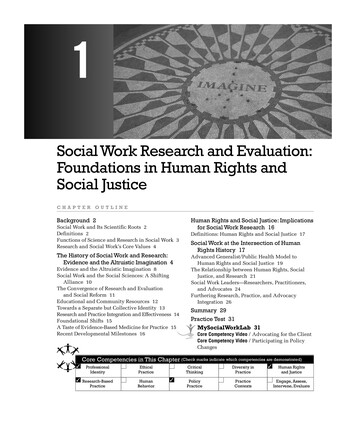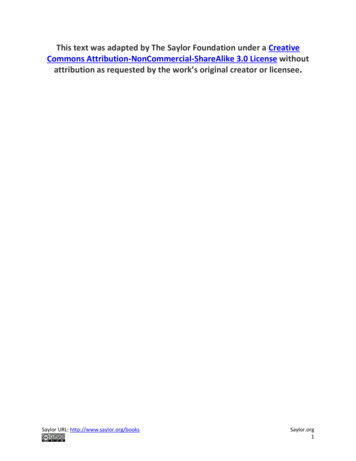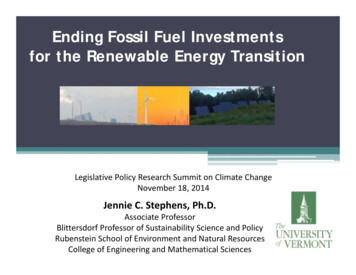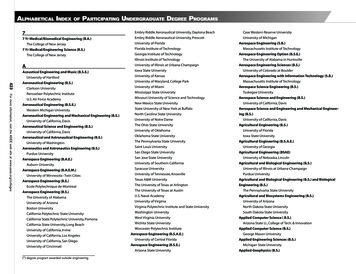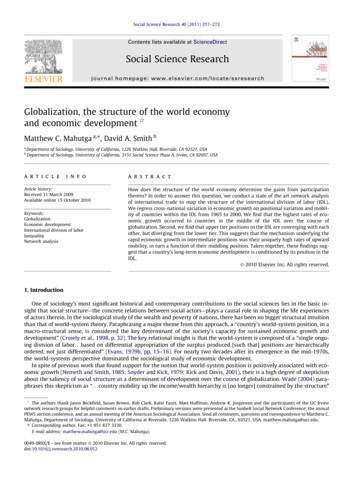
Transcription
Social Science Research 40 (2011) 257–272Contents lists available at ScienceDirectSocial Science Researchjournal homepage: www.elsevier.com/locate/ssresearchGlobalization, the structure of the world economyand economic development qMatthew C. Mahutga a, , David A. Smith babDepartment of Sociology, University of California, 1226 Watkins Hall, Riverside, CA 92521, USADepartment of Sociology, University of California, 3151 Social Science Plaza A, Irvine, CA 92697, USAa r t i c l ei n f oArticle history:Received 31 March 2009Available online 15 October 2010Keywords:GlobalizationEconomic developmentInternational division of laborInequalityNetwork analysisa b s t r a c tHow does the structure of the world economy determine the gains from participationtherein? In order to answer this question, we conduct a state of the art network analysisof international trade to map the structure of the international division of labor (IDL).We regress cross-national variation in economic growth on positional variation and mobility of countries within the IDL from 1965 to 2000. We find that the highest rates of economic growth occurred to countries in the middle of the IDL over the course ofglobalization. Second, we find that upper tier positions in the IDL are converging with eachother, but diverging from the lower tier. This suggests that the mechanism underlying therapid economic growth in intermediate positions was their uniquely high rates of upwardmobility, in turn a function of their middling position. Taken together, these findings suggest that a country’s long-term economic development is conditioned by its position in theIDL.Ó 2010 Elsevier Inc. All rights reserved.1. IntroductionOne of sociology’s most significant historical and contemporary contributions to the social sciences lies in the basic insight that social structure—the concrete relations between social actors—plays a causal role in shaping the life experiencesof actors therein. In the sociological study of the wealth and poverty of nations, there has been no bigger structural intuitionthan that of world-system theory. Paraphrasing a major theme from this approach, a ‘‘country’s world-system position, in amacro-structural sense, is considered the key determinant of the society’s capacity for sustained economic growth anddevelopment” (Crowly et al., 1998, p. 32). The key relational insight is that the world-system is composed of a ‘‘single ongoing division of labor. . .based on differential appropriation of the surplus produced [such that] positions are hierarchicallyordered, not just differentiated” (Evans, 1979b, pp. 15–16). For nearly two decades after its emergence in the mid-1970s,the world-systems perspective dominated the sociological study of economic development.In spite of previous work that found support for the notion that world-system position is positively associated with economic growth (Nemeth and Smith, 1985; Snyder and Kick, 1979; Kick and Davis, 2001), their is a high degree of skepticismabout the saliency of social structure as a determinant of development over the course of globalization. Wade (2004) paraphrases this skepticism as ‘‘. . .country mobility up the income/wealth hierarchy is [no longer] constrained by the structure”qThe authors thank Jason Beckfield, Susan Brown, Rob Clark, Katie Faust, Matt Huffman, Andrew K. Jorgenson and the participants of the UC Irvinenetwork research groups for helpful comments on earlier drafts. Preliminary versions were presented at the Sunbelt Social Network Conference; the annualPEWS section conference, and an annual meeting of the American Sociological Association. Send all comments, questions and correspondence to Matthew C.Mahutga, Department of Sociology, University of California at Riverside. 1226 Watkins Hall. Riverside, CA., 92521, USA. matthew.mahutga@ucr.edu. Corresponding author. Fax: 1 951 827 3330.E-mail address: matthew.mahutga@ucr.edu (M.C. Mahutga).0049-089X/ - see front matter Ó 2010 Elsevier Inc. All rights reserved.doi:10.1016/j.ssresearch.2010.08.012
258M.C. Mahutga, D.A. Smith / Social Science Research 40 (2011) 257–272(567). An extremely popular and influential version of this perspective argues that globalization ‘‘flattens out” the world andleads to economic dynamism everywhere, and particularly in the poorest regions (Friedman, 2005). In short, globalizationleads to rapid economic development in the periphery during the late 20th and early 21st centuries.As a point of departure, we revisit classic hypotheses regarding the distribution of economic rewards across the structureof the international division of labor (IDL). Empirically, we conduct a network analysis that allows us to map the structure ofthe IDL on a large sample of countries across a fairly long temporal range, and examine the relationship between a country’sposition and mobility in that structure and their subsequent growth trajectory. The results indicate that structure matters insignificant ways. In particular, intermediate positions in the IDL had significantly higher growth rates than other positions,which in turn is a function of their greater degree of structural mobility. Our findings highlight the contingent nature of economic development and challenge some contemporary views of economic ‘‘globalization” that posit the structure of theworld-economy no longer conditions development processes, as well as those that see globalization as intensified exploitation of non-core countries. Ultimately, we argue that our results warrant a fresh look at the structural contingencies that leadto growth and stagnation across the structure of the world-economy.2. Enhancing welfare or entrenching hierarchy? The international division of labor, economic growth and upwardmobilityThe story of winners and losers in the IDL remains an important and hotly debated topic in the social sciences. Within thisdialogue, a key question is how does the structure of the world-economy impact economic development and the wealth/poverty of nations? The key point of contention revolves around two views of the role that the international division of laborplays in the development of individual countries. As Evans (1995) argues, ‘‘the international division of labor can be seen asthe basis of enhanced welfare or as a hierarchy” (7).The ‘‘enhanced welfare” view claims that any one particular role in the IDL is not necessarily better than another, butrather that ‘‘compatibility with [a country’s] resource and factor endowments defines the activity most rewarding for eachcountry” (Evans, 1995, p. 7; also see the classic treatments of Ricardo [1817] 2004, Smith [1776] 2003). The ‘‘enhancedwelfare” position contrasts sharply with global political economy arguments that development outcomes vary by a country’sposition in the IDL (Chase-Dunn, 1998; Galtung, 1971). Indeed, the world-system perspective argues that the IDL conformsto hierarchically stratified zones with different types of production occurring across the various zones: ‘‘Core production isrelatively capital intensive and employs skilled, high wage labor; peripheral production is labor intensive and employscheap, often politically coerced labor” (Chase-Dunn, 1998, p. 77). In turn, they argue that core positions ‘‘generate a ‘multidimensional conspiracy’ in favor of development,” while peripheral ones do not (Evans, 1995, p. 7).With respect to empirical expectations regarding the association between position in the IDL and economic growth, the‘‘enhanced welfare” view presents a simple null hypothesis: if the structure of the IDL is simply ‘‘differentiated” rather thanhierarchically organized, we would expect that cross-national variation in structural location should not be a significant predictor of economic growth. On the other hand, the world-systems perspective offers two distinct hypotheses correspondingto different phases in the cycles of world-economic expansion and contraction. The first is a simple linear hypothesis—thecore grows faster than the semiperiphery and the periphery, and the semiperiphery grows faster than the periphery, whichis consistent with early ‘‘stagnationist” views of world-system dependency (Frank, 1969).An alternative world-systems account is consistent with a non-linear hypothesis—the semiperiphery grows faster thanboth the core and the periphery during particular phases in long-term Kondratieff cycles of world-economic expansionand contraction (Wallerstein, 1976). During world-economic upswings—Kondratieff A phases—core countries reap the benefits of an expansionary economy and the association between position in the IDL and economic growth is linear. However,Wallerstein suggests that the world-economy entered a downturn—and Kondratieff B phase—ca. 1967, during which therewas a ‘‘shift in relative profit advantage to the semi-peripheral nations” (Wallerstein, 1976, p. 464, 1998). Thus, select countries in the semiperiphery become the beneficiaries of the relocation of global industries to non-core countries. In otherwords, the B phase represents the greatest possibility for growth owing to the greater openness of the system to the flowof mature technologies out from the core. Therefore an alternative hypothesis emerging from this perspective is that theIDL benefits countries ‘‘in the middle” and that semi-peripheral growth will exceed that of both the core and the periphery.2.1. Mobility in the IDL and economic growthWhile there are good reasons to expect more rapid growth in the semiperiphery, the mechanisms behind this dynamismare less understood. In developing our argument, we draw on a large and growing literature on global commodity chains,which focuses on the way in which firms from the lower tier of the IDL link up with those at upper tiers of the IDL in orderto ‘‘upgrade” their role in the chain at the firm level, and the IDL at the level of the national economy (Bair, 2005; Gereffi andKorzeniewicz, 1994; Gereffi et al., 2001; Gereffi and Memedovic, 2003; Memedovic, 2004).A major issue within this literature is whether or not upward mobility generates positive development outcomes. Someare willing to acknowledge that the ‘‘growth miracles” in countries such as South Korea, Singapore, Taiwan and Hong Kongstem from real upward mobility via the internalization of a growing share of manufacturing flowing out from core countries(Chase-Dunn, 1998). Others tend to argue that what appears to be upward mobility—the growth in manufacturing activity
M.C. Mahutga, D.A. Smith / Social Science Research 40 (2011) 257–272259among non-core countries—actually reflects the desire of core firms to shift less profitable manufacturing activities ontomore vulnerable firms at lower tiers of the IDL (Arrighi et al., 2003). In other words, detractors from the upgrading hypothesis suggest that upward mobility in the IDL is not a viable development strategy because it creates greater competition informerly core economic activities: ‘‘the very success of Third World countries in internalizing within their domains theindustrial activities with which First World wealth had been associated activated a competition that sharply reduced thereturns that previously had accrued to such activities” (Arrighi et al., 2003, p. 23).A second point of contention involves whether or not upward mobility is viable, stemming from disagreements over ‘‘thedegree of mobility within the system available to individual states” (Chase-Dunn, Christopher and Peter Grimes, 1995,p. 397). Some argue that ‘‘it is highly unlikely that countries with little to no advanced industry can move up because theylack the necessary levels of capital, infrastructure, workforces skills and technical expertise to do so” (Mahutga, 2006,p. 1865). Classic dependency theory, exemplified by Frank (1969), presents an extremely ‘‘stagnationist” version of this position. On the other hand, even within this tradition there is an interest in discovering how ‘‘dependency reversal” can lead tosome form of more autonomous growth in relation to ‘‘external” global structures (Gereffi, 1983; Evans, 1979a,b). The idea of‘‘dependent development” (see, especially Evans, 1979a) explicitly theorized the possibility of upward mobility in the worldsystem, particularly among the newly industrializing countries (Caporaso, 1981; Deyo, 1987).Empirically, there are examples of upwardly mobile countries that experience real development (e.g. Amsden, 2001;Evans, 1979a; Gereffi and Wyman, 1990), those that seem to experience upward mobility without subsequent economicdevelopment (e.g. Schrank, 2004), and still other cases that experience neither mobility nor development (e.g. Frank,1969). As a resolution to these points of contention, we suggest that some unique characteristics of countries in the middleof the IDL may give us some theoretical leverage in understanding these disagreements.We start by acknowledging that upward mobility—or industrial upgrading—stems, at least to a large degree, from the outsourcing decisions of, and/or technological diffusion from, firms in core countries (Bair, 2005; Dicken, 2003; Gereffi, 1994;Gereffi and Memedovic, 2003; Gereffi and Korzeniewicz, 1994; Parente and Prescott, 2000), and therefore suggest that upward mobility over the course of economic globalization is in part a function of a site’s attractiveness to and ability to absorbtechnology and knowledge from these actors. Thus, while many assume that countries have equal access to the world stockof ‘‘usable knowledge” and a minimum infrastructural basis to implement advanced production technologies (Parente andPrescott, 2000), we suggest that semi-peripheral countries are more attractive sites of industrial migration than both coreand peripheral countries.First, semi-peripheral countries contain either ‘‘a relatively equal mix of core and peripheral types of production,” or ‘‘apredominance of activities which are at intermediate levels with regard to the current world-system distribution of capitalintensive/labor intensive production” (Chase-Dunn, 1998, pp. 77, 212). As a consequence of these intermediate forces of production, labor costs are lower in semi-peripheral countries than in the core while their ability to implement advanced production processes is higher than in the periphery. Thus, semi-peripheral countries are more attractive than alternative coreand peripheral countries as sites of industrial migration, and thus have higher ‘‘absorptive capacity.” Second, many semperipheral nations may be an attractive alternative to peripheral sites because firms that relocate to poorer countries must balance the expected gains from lower production costs against the amount of time required for the new location to producecomparable commodities to the home country, and more experience translates into a steeper learning curve (Thun, 2008;Wood, 1994). Indeed, absorptive capacity may very well be cumulative such that countries who gain experience and competence with one firm or industry often become more attractive to others and early experience leads to greater future access(Cohen et al., 2009). Thus, the question of mobility’s impact on development may be resolved by arguing that mobility is aviable developmental path, but that semi-peripheral countries occupy structural positions that encourage upward mobilitymore than peripheral ones. Thus, our final hypothesis is that differential rates of upward mobility explain any variation ingrowth across positions in the IDL.3. Network methods and data3.1. Roles and positions in the IDLWe begin by identifying the structure of the IDL and the position of individual countries within it.Our approach follows the classic literature on the identification of roles and positions in network analysis (Wasserman andFaust, 1999, pp. 347–393; 461–502; Dorien et al., 2005), implemented in a wide variety of empirical contexts (Anheier andGerhards, 1991; Boorman and White, 1976; Mullins et al., 1977 White et al., 1976), and in studies of the structure of theworld economy in particular (Alderson and Beckfield, 2004; Breiger, 1981; Mahutga, 2006; Nemeth and Smith, 1985; Smithand White, 1992; Snyder and Kick, 1979; Van Rossem, 1996).At a conceptual level, the identification of roles and positions begins with the intuition that actors in similar structuralpositions should have relatively isomorphic patterns of relations to others. Thus, the goal is to identify similarly positionedactors by the extent to which they have interchangeable patterns of relationships. The method starts with a relation or set ofrelations and then (1) estimates the degree of similarity between each pair of actors with an equivalence criterion, (2) usesthese estimates as the basis for assigning actors to relatively equivalent structural positions, and sometimes (3) determinesthe role played by each of the equivalent groups (or ‘‘blocks” in the block model literature) by analyzing the relations between them.
260M.C. Mahutga, D.A. Smith / Social Science Research 40 (2011) 257–272Over time, network based role and position analyses that quantify the world-economy evolved from strict to more general equivalence criteria (Lloyd et al., 2009). Earlier studies used structural equivalence as the criterion (e.g. Snyder and Kick,1979). For a pair of actors to be structurally equivalent, they need identical patterns of relations with identical others. Yet,structural equivalence overlooks the situation in which two countries could have identical patterns of relationships to partners that are not identical, but nonetheless occupy identical positions in the network. A classic example is that of managersand subordinates across multiple departments in a firm. Given a relationship of ‘‘gives orders to,” it is clear that managers indifferent departments would not be structurally equivalent because the subordinates to whom they give orders are in different departments, even though they occupy identical social roles as subordinates, or order takers.A more general criterion is regular equivalence. Regular equivalence identifies actors who have similar patterns of ties toequivalent (rather than identical) others (Wasserman and Faust, 1999, p. 473). More formally, ‘‘two points in a network areregularly equivalent if and only if for each tie one has with another point, the self-equivalent point has an identical tie withan other-equivalent point” (White and Reitz, 1983, p. 12). Returning to the example of managers and subordinates in a firm,the managers would play equivalent roles by virtue of their identical patterns of giving orders to subordinates, who arethemselves equivalent by virtue of their identical pattern of receiving orders from managers. Thus, it has been shown thatregular equivalence is appropriate over stricter types of equivalencies because it is a more general measure of role similarity(see Batagelj et al., 1992; Faust, 1988; Wasserman and Faust, 1999; White and Reitz, 1983; White, 1984; Ziberna, 2008).The first step in our analysis obtains the degree of regular equivalence between each country pair in our sample acrossfive different trade relationships (see below) at each time point. We obtain the regular equivalence between each countrypair via the REGE algorithm in UCInet (Borgatti et al., 2002; see Wasserman and Faust, 1999 and Ziberna, 2008 for extensivemathematical and conceptual discussion, and Alderson and Beckfield, 2004; Mahutga, 2006 and Smith and White, 1992 forimplementations).1 The REGE algorithm identifies the level of regular equivalence between each pair of countries. Given a focaldyad ij, REGE finds the best matching set of ties between i’s ties with its neighborhood and j’s ties with its neighborhood andweights the match by the equivalence of the two neighborhoods. This match is expressed as a ratio of the maximum possibleequivalence, which would occur if every tie from i to its neighborhood could be perfectly matched by a tie from j to its neighborhood, and the two neighborhoods were perfectly equivalent. It is highly unlikely that any two nations would be exactlyequivalent, so our multi-relational regular equivalence analysis produces a single equivalence matrix consisting of an equivalence measure for each pair of countries between maximally dissimilar (0) and regularly equivalent (1) in each period.Having identified the level of regular equivalence between each pair of countries, our second step combines two complementary techniques—correspondence analysis and hierarchical clustering—to identify the structural positions in whichcountries are located. We use a ‘‘complete link” hierarchical clustering routine to identify groups of countries that areapproximately regularly equivalent. The complete link clustering routine starts by assigning each country to its own clusterso that the similarities between each cluster equals the similarity between each country. The second step finds the most similar pair of countries and merges them into a single cluster, resulting in N-1 clusters. The third step recomputes the similarities between new cluster as equal to the maximum similarity between any individual member of a given cluster and anyindividual member of another cluster. Steps 2 and 3 are repeated until all countries are clustered into a single cluster of sizeN (Borgatti, 1994; Johnson, 1967; Wasserman and Faust, 1999). The hierarchical clustering routine produces many possiblesets of equivalent groupings that span the continuum from trivial sets in which each actor occupies its own position to one inwhich all actors occupy the same position, so we use these results in conjunction with correspondence analysis that we discuss below to identify the country positions.2At a conceptual level, correspondence analysis represents the matrix of regular equivalencies in a low-dimensionalEuclidian space by assigning coordinates to actors that place them close to those with whom they are similar and far fromthose with whom they are dissimilar (Greenacre, 1984; Weller and Romney, 1990). Computationally, correspondence analysis decomposes the information contained in a data matrix into three matrices: an N-1 dimensional U matrix summarizingthe information in the rows, an N-1 dimensional V matrix summarizing the information in the columns, and an N-1 diagonald matrix of singular values that summarizes the amount of variance explained by each dimension of U and V, where largersingular values correspond to higher explained variance. Because our correspondence analysis is standard, we refer the interested reader to orthodox texts for the technical aspects of the analysis (Greenacre, 1984; Weller and Romney, 1990).3.2. Commodity trade dataThe data underlying our measure of role/position in the IDL are trade in commodity groups from UN COMTRADE, classified under the Standard International Trade Classification (SITC, Rev. 1) and collected at three time points: 1965, 1980 and1The REGE program is iterative and updates the equivalence of each pair of countries at each iteration and we use the default specification of three iterationsas suggested in the literature (Faust, 1988). Each trade matrix was transformed with the base 10 logarithm to reduce skew prior analysis with the REGEalgorithm.2In principle, an analyst could start out with some a criterion whereby actors i and j would be placed in the same group if REij a. However, there is no apriori theory that favors one level of a over another, large real world data sets are rarely broken down into discrete homogenous groups at any single a and theauthoritative guide states simply that the ‘‘trick is to find the most useful and interpretable partition of actors into equivalence classes” (Wasserman and Faust,1999, p. 383).
M.C. Mahutga, D.A. Smith / Social Science Research 40 (2011) 257–2722612000 (United Nations, 1963). Rev. 1 of the SITC consists of 55 categories at the two-digit level. However, we collect data on 15two-digit U.N. categories displayed in Table 1, for two reasons3.First, as discussed above, the measurement of roles and positions is based on the supposition that similarly positionedactors are defined by the similarity in their relationships to others in the network. In the case of country level positionsin the structure of the IDL, this supposition must account for the organizational variation between industries, both knownand unknown. For example, ‘‘core” nodes in labor intensive industries—or buyer-driven commodity chains—are currentlyidentifiable by their tendency to import (or buy) from a geographically diffuse set of low-wage countries, rather than produce and export. On the other hand, ‘‘core” nodes in capital and technology intensive industries—or producer-driven commodity chains—are currently identifiable by their tendency to engage in scale intensive production and either domesticconsumption or exports (Bair, 2005; Gereffi, 1994; Mahutga, 2011). In short, patterns of trade—imports and exports in thiscase—do not mean the same thing across different types of commodities because of differences in the way their production isorganized, such that similarly positioned countries should have relatively equivalent patterns of trade relationships acrossdifferent types of industries.Second, while the organization of some types of industries is well known—the garment industry is a prime example—thatof other industries is less understood. Thus, it is difficult to determine which industries are necessary to represent the fullspectrum of organizational variation that exists. Our approach is to draw from five categories identified by Smith and Nemeth (1988). Using factor analysis, Smith and Nemeth (1988) found that the 55 two-digit UN commodity categories clusterinto 5 more or less equivalent types of trade relationships based on the pattern of their exchange between countries. In otherwords, the 5 relational categories in Table 1 capture the full spectrum of UN categories from which to choose, such that wecan account for the UN’s 55 two-digit commodity categories with the 5 broad relationships in Table 1 at the same time thatwe retain all the meaningful organizational variation that exists between commodity categories. In order to simplify ouranalyses, we take the sum of the three matrices within each category in Table 1 to produce five matrices representing eachof the five types of relationships uncovered by Smith and Nemeth (1988) in 1965, 1980 and 2000.4The 94 countries in our sample are representative of all world-regions, and contain a large number of less developedcountries. Collectively, the sample accounts for between 92 and 98 percent of world GDP over time, between 96 and 99 percent of world trade over time, and roughly 80 percent of world population over time (see Table 2 for a list of includedcountries).54. Hypothesis testing: data and methods4.1. Data4.1.1. Dependent variableThe dependent variable in the regressions that follow is the standard annualized growth rate of per capita gross domesticproduct (GDP) for each country.4.1.2. Independent variables4.1.2.1. International division of labor/world-system position. We use indicators of core, semiperiphery and periphery that areidentified in the categorical representation of our network analysis. This maximizes the comparability of this research withprevious work (e.g. Snyder and Kick, 1979; Kick and Davis, 2001; Van Rossem, 1996; Nemeth and Smith, 1985).4.1.3. World-system mobilityWorld-System mobility is derived from the continuous representation of our network analysis, and is defined below andin Table A2. Conceptually, this variable captures the change in distance between a focal non-core country and the center ofthe core group over time.4.1.4. GDP per capitaControlling for initial levels of GDP per capita has become fairly standard practice in neo-classical models of economicgrowth (e.g. Barro and Sala-i-Martin, 1995).4.1.5. Human capitalSecondary education enrollment rates are seen as key determinants of growth insofar as they proxy for the cross-nationalvariation in the stock of human capital (Barro and Sala-i-Martin, 1995).3Given an N [ N matrix where cell ij represents the export from actor i to actor j, one can use either actor i’s reported exports, or actor j’s reported imports tomeasure j’s import from i, or equivalently, i’s export to j. While export and import data are very highly correlated, reported imports tend to be more accuratebecause of the care taken by state agencies to record imports accurately for the purpose of tariffs (Durand, 1953). Thus, we use reported imports, measured incurrent US dollars, to measure both imports and exports between each country.P4By sum we meanARij ¼ Rr¼1 ijr , where r indexes the matrices in relation R.5Two countries (Czechoslovakia and Yugoslavia) in our data set disintegrated over the period studied, and we imputed their values by either summing (inthe case of trade and GDP) or averaging (in the case of percentage based attributes) across the newly formed constituent republics.
262M.C. Mahutga, D.A. Smith / Social Science Research 40 (2011) 257–272Table 1UN commodity categories classified in relational categories from Smith and Nemeth (1988).1) High tech/heavy manufacturing (HTHM)58) Plastic materials, regenerated cellulose and artificial Resins69) Manufactures of metal71) Machinery–nonelectrical2) Sophisticated extractive (SOEX)25) Pulp and waste paper34) Gas, natural and manufactured64) Paper, paperboard, and manufactures thereof3) Simple extractive (SIEX)04) Cereal and cereal preparations22) Oil seeds, oil nuts and oil kernels41) Animal oils and fats4) Low-wage/light manufactures (LWLM)83) Travel bags, handbags, and similar containers84) Clothing85) Footwear5) Animal products and byproducts (APAB)01) Meat and meat preparations02) Dairy products and bird’s eggs29) Crude animal and vegetable materials4.1.6. Trade opennessTrade openness plays a dual role in this analysis. On one hand, trade openness captures either the effect of governmentinduced open trade policy (IMF,
Mahutga, Department of Sociology, University of California at Riverside. 1226 Watkins Hall. Riverside, CA., 92521, USA. matthew.mahutga@ucr.edu. Corresponding author. Fax: 1 951 827 3330. E-mail address: matthew.mahutga@ucr.edu (M.C. Mahutga). Social Science Research 40 (2011) 257-272 Contents lists available at ScienceDirect Social .

